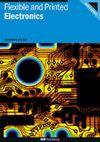Flexible humidity sensor for smart agricultural applications
IF 3.2
4区 工程技术
Q3 MATERIALS SCIENCE, MULTIDISCIPLINARY
引用次数: 0
Abstract
In order to meet the increasing food demand, sensors that measure the ambient temperature and humidity in greenhouses are needed for more efficient vegetable and fruit production. For this purpose, two different flexible and resistant textile-based humidity sensors that can measure the humidity at higher levels (80%, 90%, and 100% relative humidity (RH)) were designed and printed directly on the four different greenhouse fabrics using silver and carbon conductive inks. Depending on the humidity value in the environment, the sensor performance was tested based on sensor electrical resistance measurements with respect to repeated bending/cyclic tests, rubbing, ultraviolet (UV) exposure/ weatherability (against UV and raining) tests in order to simulate greenhouse conditions for smart agriculture. Despite applying 1024 bending cycles, up to 20 rubbing cycles, and 10 times UV and rain exposure to the humidity sensors at high RH, no significant change was detected in the resistance values of the humidity sensors. Moreover, some important features of the sensors such as hysteresis, repeatability, response time have been also examined. According to hysteresis test results, humidity sensors show acceptable dynamic response and response time of the sensors are 15.8, 17.3, 24.8, and 25 s at 100% RH for G2S, W1S, B2C, and W1C, respectively. Statistical analyses showed that the sensor designs and type of conductive inks had significant effects on the performance of the humidity sensors and the best sensor performance was obtained with the polypropylene coated fabric using design II and silver based conductive ink. The fabricated textile based flexible humidity sensors detect the change in RH levels from 80% RH to 100% RH and achieve good durability, and repeatability even after prolonged UV exposure and raining. Thus, the developed textile-based flexible humidity sensor might be useful for future smart agricultural applications.用于智能农业应用的柔性湿度传感器
为了满足日益增长的食品需求,需要在温室中测量环境温度和湿度的传感器来提高蔬菜和水果的生产效率。为此,设计了两种不同的柔性和耐湿度的基于纺织品的湿度传感器,可以测量更高水平(80%,90%和100%相对湿度(RH))的湿度,并使用银和碳导电油墨直接印刷在四种不同的温室织物上。根据环境中的湿度值,基于传感器电阻测量进行了传感器性能测试,包括反复弯曲/循环测试、摩擦、紫外线(UV)暴露/耐候性(抗紫外线和降雨)测试,以模拟智能农业的温室条件。尽管在高相对湿度条件下,对湿度传感器施加1024次弯曲循环,最多20次摩擦循环以及10次紫外线和雨水暴露,但湿度传感器的电阻值没有明显变化。此外,还研究了传感器的一些重要特性,如滞后、可重复性、响应时间等。根据滞回测试结果,G2S、W1S、B2C和W1C在100% RH条件下,湿度传感器的动态响应可以接受,响应时间分别为15.8、17.3、24.8和25 s。统计分析表明,传感器的设计和导电油墨的种类对湿度传感器的性能有显著影响,使用设计II和银基导电油墨的聚丙烯涂层织物获得了最佳的传感器性能。制造的基于纺织的柔性湿度传感器可以检测RH水平从80% RH到100% RH的变化,并且即使在长时间的紫外线照射和下雨后也具有良好的耐久性和可重复性。因此,所开发的基于纺织品的柔性湿度传感器可能对未来的智能农业应用有用。
本文章由计算机程序翻译,如有差异,请以英文原文为准。
求助全文
约1分钟内获得全文
求助全文
来源期刊

Flexible and Printed Electronics
MATERIALS SCIENCE, MULTIDISCIPLINARY-
CiteScore
4.80
自引率
9.70%
发文量
101
期刊介绍:
Flexible and Printed Electronics is a multidisciplinary journal publishing cutting edge research articles on electronics that can be either flexible, plastic, stretchable, conformable or printed. Research related to electronic materials, manufacturing techniques, components or systems which meets any one (or more) of the above criteria is suitable for publication in the journal. Subjects included in the journal range from flexible materials and printing techniques, design or modelling of electrical systems and components, advanced fabrication methods and bioelectronics, to the properties of devices and end user applications.
 求助内容:
求助内容: 应助结果提醒方式:
应助结果提醒方式:


